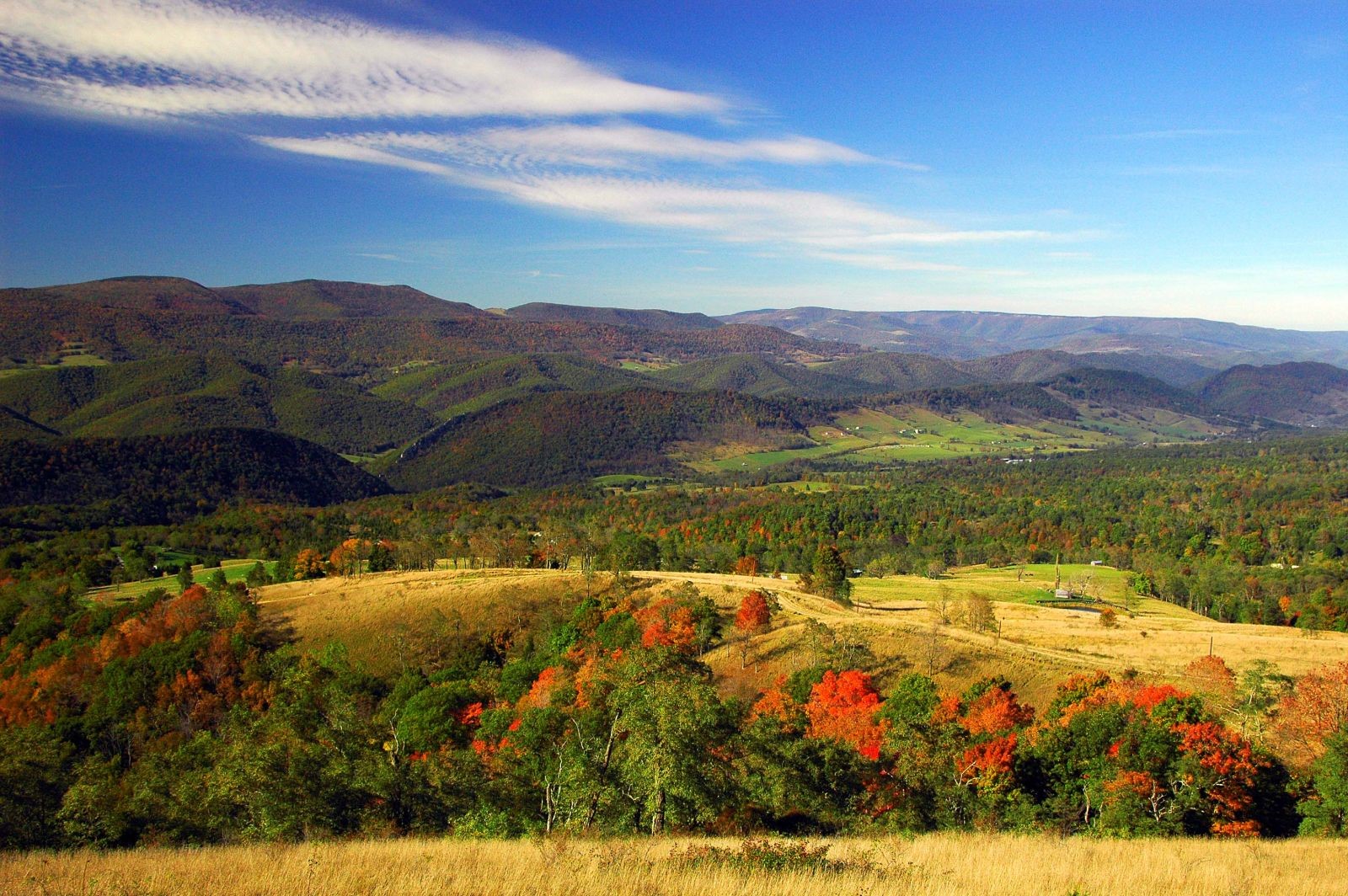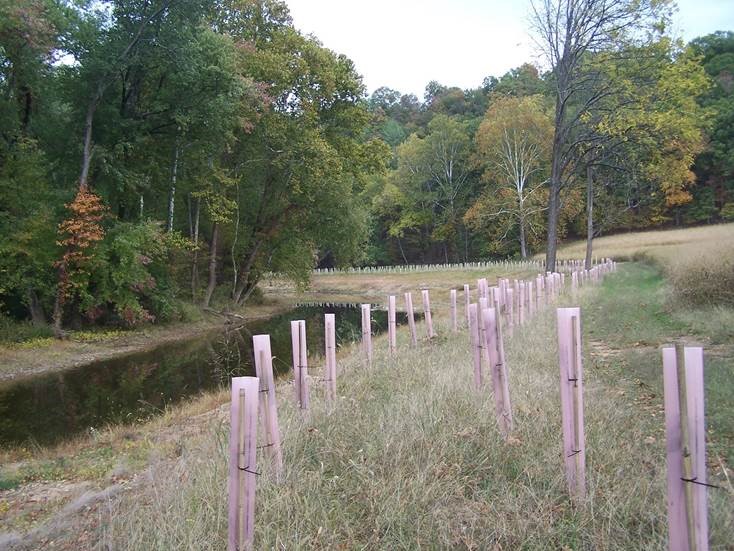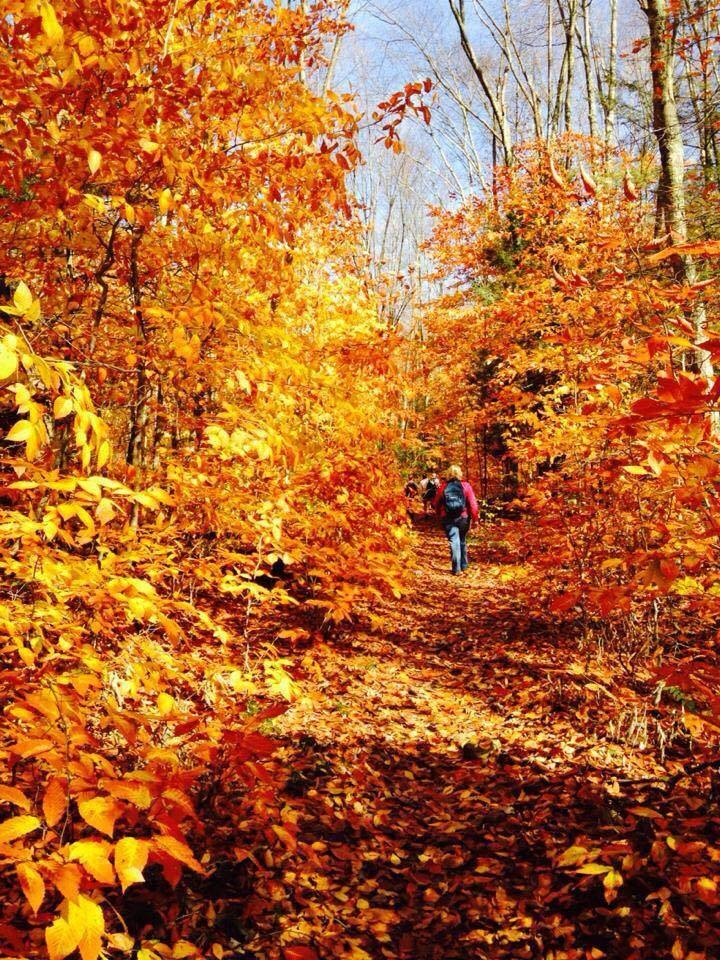Forestry

Forestland in general is a large contributor of nutrients into the Bay watershed due to the magnitude of forested acres in West Virginia. Acre for acre though, forestland is the best land use in the model for low nutrient and sediment gains.
Seventy-eight percent (78%) of WV is forested, making West Virginia  the third most heavily forested state in the nation. Six out of the eight counties in the Bay drainage are >78% forested. Over 98% of forestland in the state is classified as commercial forestland which is available for timber harvesting. Forestry plays an important part in the economy of West Virginia and to the counties in the Bay drainage. Timber harvesting does contribute to increased runoff from harvested forests in the short term.
Riparian Forested Buffers
A Riparian Forest Buffer
(RFB) is an area of trees and shrubs located adjacent to streams, lakes, ponds, and wetlands. Riparian forest buffers of sufficient width intercept sediment, nutrients, pesticides, and other materials in surface runoff and reduce nutrients and other pollutants in shallow subsurface water flow. Maintaining or re-establishing Riparian Forested Buffers in the Potomac Drain counties is a priority for partners working in the Bay drainage counties. RFB strategies involve many agencies working together in WV and as part of the larger picture with other Bay states.
Follow this link to the recent RFB strategy:
http://www.chesapeakebay.net/publications/title/riparian_forest_buffer_management_strategy
Cost share opportunities are available to assist with the costs associated with implementing buffers. The USDA Farm Service Agency Conservation Reserve Enhancement Program is one of the tools West Virginia is relying on to meet our goals. Learn how CREP can help you on your farm and about the many practices available at a high cost-share rate
CREP (Conservation Reserve Program) Fact Sheet -3-12 revision
Urban Tree Canopy
A major part of forestry is the urban side. West Virginia partners are actively involved in several areas to increase the urban tree canopy in the Potomac Highlands.
Cacapon Institute (CI) is taking the lead on many canopy initiatives and was a major contributor in the recent
Urban Tree Canopy Management Strategy.
This strategy has the goal of expanding tree canopy Bay-wide by 2,400 acres by 2025. WV's contribution to the goal is 10 acres annually. This will be accomplished mainly through
West Virginia Project CommuniTree, Bay Community Grants, and 319 plantings. In addition CI is developing a self-reporting website to allow the public to report tree plantings.
Forest Conservation
The
Forest Legacy Program provides federal cost-share dollars to the state for the purchase of, in fee or by easement, private properties that are environmentally significant. The program assures that the forest resource will continue as a "working forest" forever. Protecting and conserving the forestland in the Bay watershed in also an important practice in nutrient and sediment reduction. Protecting forests helps sustain drinking water supplies and critical wildlife habitat as well. Local, state, and federal governments have been at the forefront of creating public funding for land conservation. On the local side in West Virginia, the funding is mainly through
county farmland protection boards with money obtained through real estate transfer fees. Often there are woodlots on these farms that are part of the easements.
Forest Harvesting
The
WV Division of Forestry (WVDOF) enforces the
Logging Sediment Control Act (LSCA) which regulates the sediment that is released through timber harvest The law empowers the WVDOF to issue compliance orders, suspend logging activities, seek civil penalties to prevent sedimentation, and/or issues citations under 19-1B-12.
Best Management Practices (BMPs) are required by law in West Virginia to be used by timber operators. BMPs are reviewed every three years by a panel of experts to ensure the latest technology is being utilized:
Timber Operators are required to be licensed and have a certified logger on site. Small landowners who operate are not required to have a license but must file for an exemption. The exemption process only excludes the operator from the licensing and certification but they must comply with BMPs to the same degree as those licensed. Timber Operators are required to be trained every three years in BMPs, chainsaw safety, and first aid. Recertification training covers subjects in reclamation, silviculture, business management, sustainable forestry, equipment safety, etc.
Emphasis has been placed on Streamside Management Zones (SMZ) to prevent exposure of mineral soil and potential erosion. The minimum SMZ width for perennial or intermittent streams is 100 feet slope distance. On ephemeral streams the SMZ is 25 feet. Soil disturbance in these areas must be minimized. BMP standards require roads to be seeded and mulched to control erosion once a logging operation has been completed.
While we know that forested watersheds reliably yield clean water, the simple act of conservation is not the last step. Conserved forests need to be managed to maintain forest health and resilience over time. Monitoring for insects and disease and invasive plant species are two aspects of forest management. There are many issues as well that relate to water quality when it comes to forest management.
For more information on these practices and other services and opportunities offered for forestry, please contact the
West Virginia Division of Forestry at (304) 558-2788.




